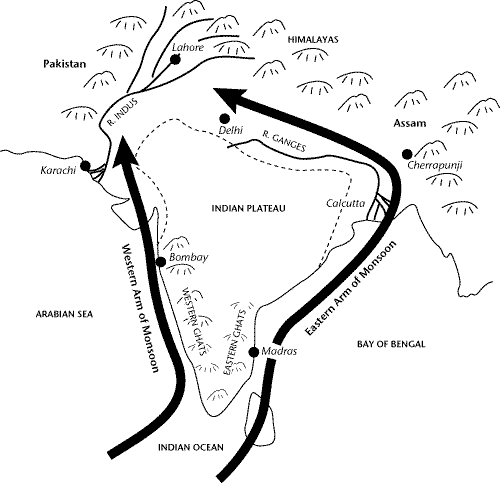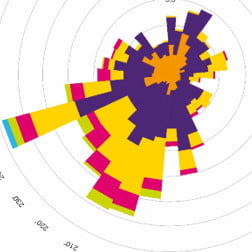The word monsoon is derived from the Arabic word ‘mausim’, meaning season. It was first used by Arabic navigators to describe the seasonal winds of the Arabian Sea. These generally blow from the north-east for one half of the year, and from the south-west for the other half. Although the term monsoon actually means a seasonal wind, it is often used to refer to the torrential rainfall associated with these winds.
 Monsoons occur mainly in tropical regions – northern Australia, Africa, South America and the USA. However, the best known area affected by monsoons is south-east Asia, particularly India. During the winter, air over the Siberian plateau becomes colder than air over the surrounding seas, producing a large anticyclone with winds circulating clockwise, thus causing cool north-easterly winds to blow across India and its neighbouring countries. This brings dry, pleasant weather, and has a marked drying effect on the land. During April and May the winds abate, causing temperatures to rise rapidly to over 35 °C.
Monsoons occur mainly in tropical regions – northern Australia, Africa, South America and the USA. However, the best known area affected by monsoons is south-east Asia, particularly India. During the winter, air over the Siberian plateau becomes colder than air over the surrounding seas, producing a large anticyclone with winds circulating clockwise, thus causing cool north-easterly winds to blow across India and its neighbouring countries. This brings dry, pleasant weather, and has a marked drying effect on the land. During April and May the winds abate, causing temperatures to rise rapidly to over 35 °C.
 In the summer the process reverses. The Siberian plateau is now warmer than the seas, and low pressure develops over these seas. The winds circulate anticlockwise and approach India from the south-west, bringing very moist air. These south-westerly winds bring a drop in temperature and heavy downpours of rain. In fact, during this monsoon, which generally lasts from June to September, India receives virtually all its rainfall for each year.
In the summer the process reverses. The Siberian plateau is now warmer than the seas, and low pressure develops over these seas. The winds circulate anticlockwise and approach India from the south-west, bringing very moist air. These south-westerly winds bring a drop in temperature and heavy downpours of rain. In fact, during this monsoon, which generally lasts from June to September, India receives virtually all its rainfall for each year.
 The mountains of southern India split the summer winds. The western arm of the monsoon is deflected northwards, by the western Ghats, to Bombay and then on to Pakistan. The eastern arm travels up through the Bay of Bengal to Calcutta and Assam, and is deflected north-westwards by the Himalayas. On average, the winds arrive in southern India about six weeks before they arrive in north-west India.
The mountains of southern India split the summer winds. The western arm of the monsoon is deflected northwards, by the western Ghats, to Bombay and then on to Pakistan. The eastern arm travels up through the Bay of Bengal to Calcutta and Assam, and is deflected north-westwards by the Himalayas. On average, the winds arrive in southern India about six weeks before they arrive in north-west India.




